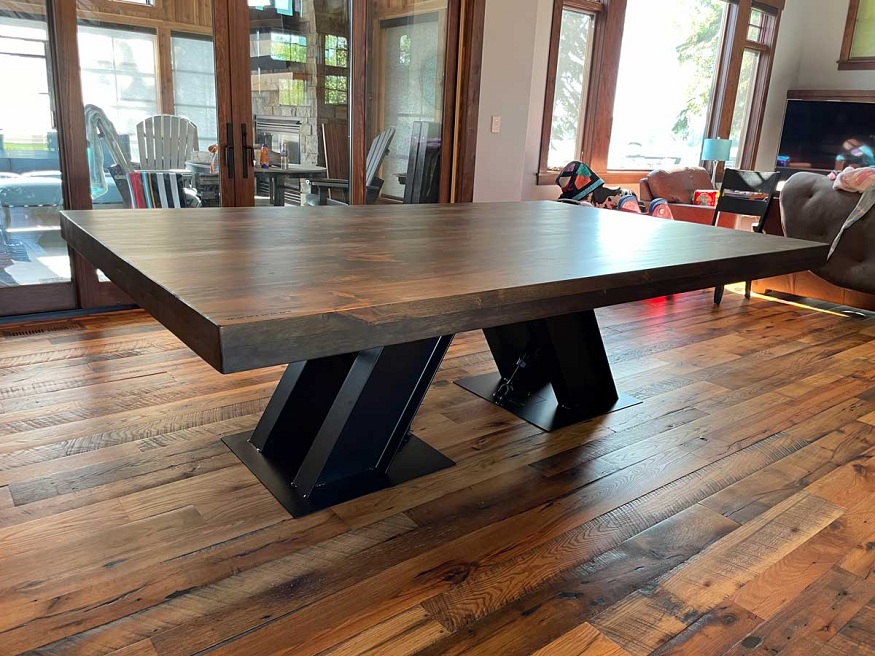When it comes to home décor, nothing brings a touch of nature, elegance, and craftsmanship quite like a custom live edge table. Whether it’s a dining table, coffee table, or kitchen centerpiece, these tables are as functional as they are unique, blending seamlessly with a variety of interior design styles. In this blog, we’ll explore how to integrate a custom live edge table into your home and what to consider for the perfect setup.
The Best Way to Incorporate a Custom Live Edge Table
Choose the Right Type of Wood for Your Space
Selecting the right wood is one of the first steps in customizing your live edge table. Popular choices include walnut, oak, cherry, and maple, each offering a distinct look and feel. Walnut, for instance, is known for its rich, dark hue, making it perfect for modern or industrial styles, while maple and oak, with their lighter shades, suit more traditional or rustic interiors.
If you’re aiming for a more artistic vibe, you might consider epoxy tables for sale, where the resin is combined with natural wood to create a stunning visual contrast. The addition of epoxy adds durability and color, allowing you to choose the best match for your interior.
Balance the Room’s Layout with the Table’s Placement
Placing your live edge table in the right spot is the key to ensuring it integrates seamlessly into your home. In a dining room, allow for at least 36-48 inches of clearance around the table for easy movement. This will also prevent the room from feeling cramped.
For a coffee table, place it centrally in front of a sofa or seating arrangement, leaving about 18 inches between the edge of the sofa and the table. This ensures accessibility while maintaining a balanced layout. If you’re integrating a live edge coffee table, be mindful of other functional elements, such as cabinets, appliances, and seating areas, to avoid overcrowding the space.
Blend Styles for a Cohesive Look
One of the greatest advantages of live edge tables is their versatility. They complement a wide range of styles from rustic to contemporary, industrial, and even minimalist designs. When choosing other furniture and décor, aim for complementary pieces. For instance, custom dining tables with a natural wood finish should be paired with modern chairs to create a striking contrast.
For a live edge wood coffee table, you might want to combine it with softer, upholstered furniture to soften the ruggedness of the natural wood. Layering with throw pillows and rugs in neutral tones can add warmth and cohesion to the room.
Focus on Lighting to Highlight Your Table
Proper lighting can make your custom made dining tables stand out even more. In the dining room, a statement chandelier or pendant light hanging directly above the table will draw attention and illuminate its unique features. For living rooms, position your live edge coffee table near a floor lamp or beneath recessed lighting to ensure it gets the focus it deserves.
In the kitchen, under-cabinet lighting or pendant lights over a custom kitchen table can bring out the table’s details, enhancing the visual appeal.
Incorporate Functional Décor and Accessories
Adding decorative pieces such as vases, sculptures, or centerpieces can accentuate the natural beauty of your live edge table without overpowering it. Choose items that reflect your personal style, but keep it minimal so that the table remains the star of the show.
For a custom dining table, consider placing a runner or a set of simple, elegant placemats. For coffee tables, a stack of books or a decorative tray can add function while keeping the aesthetic clean and modern.
Conclusion
Incorporating a custom live edge table into your home’s layout brings both beauty and function into your space. Whether you’re choosing a custom kitchen table, a live edge wood coffee table, or a custom dining table, these pieces enhance the overall design of your home while providing a connection to nature. By selecting the right wood, placement, and décor, you’ll create a space that feels both inviting and uniquely yours.

